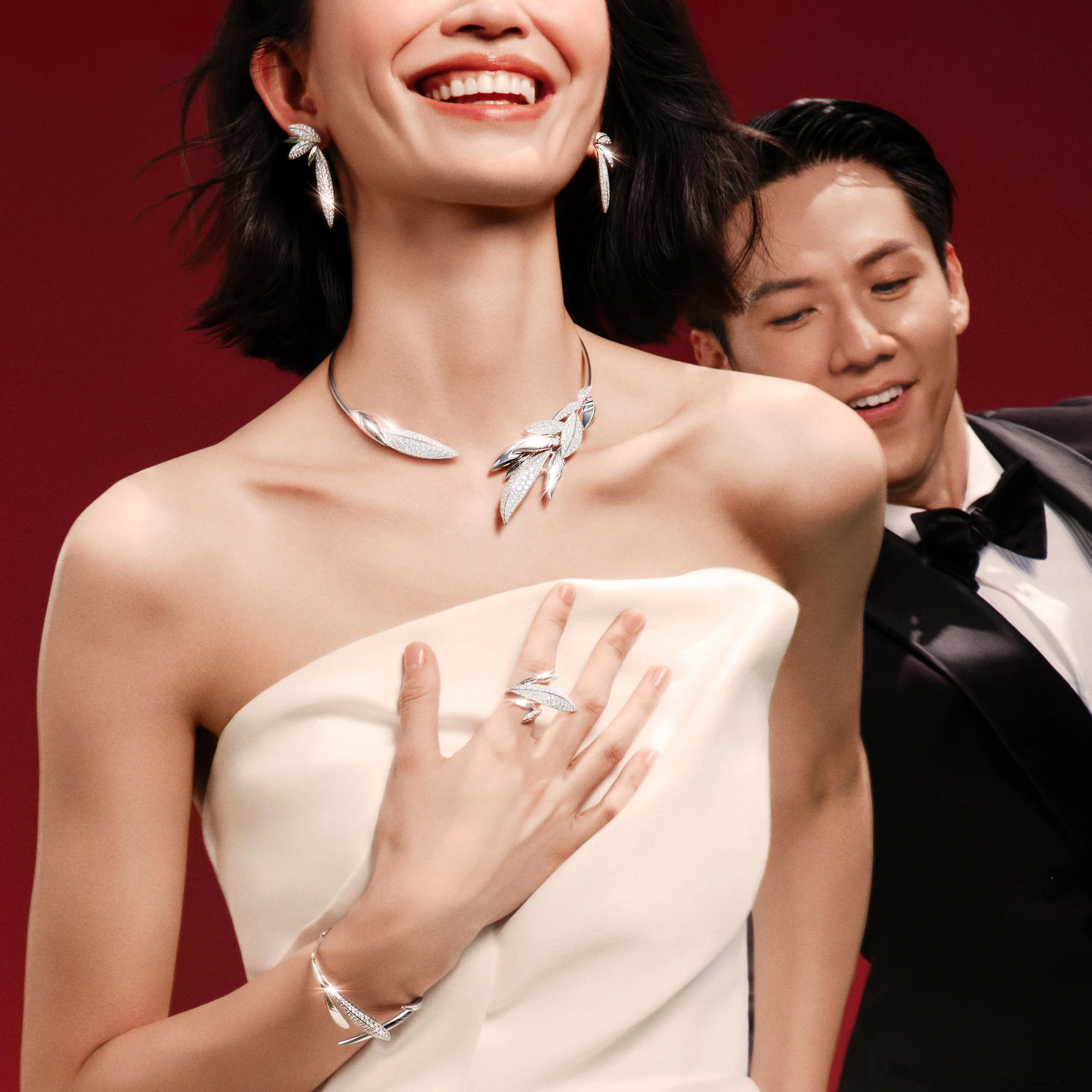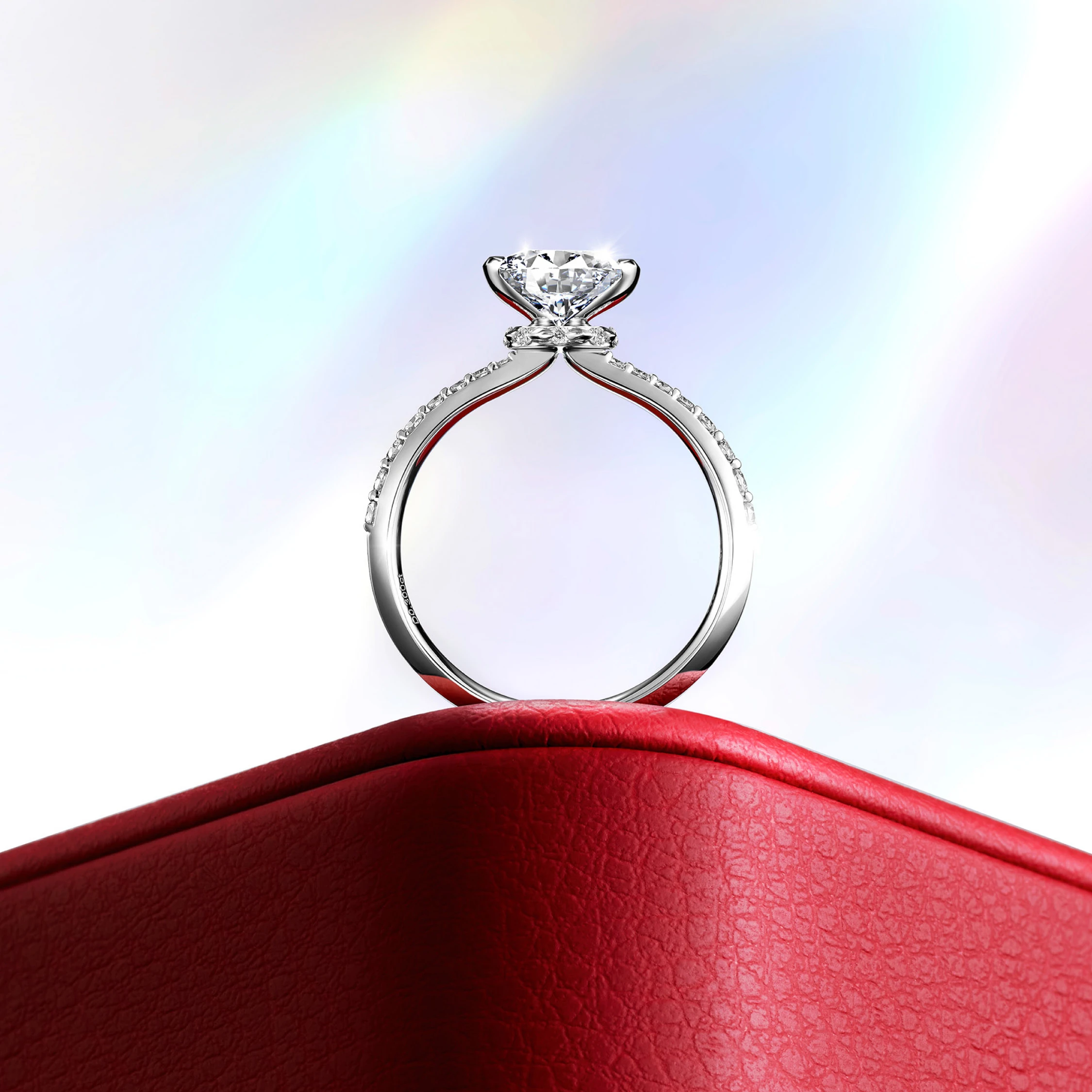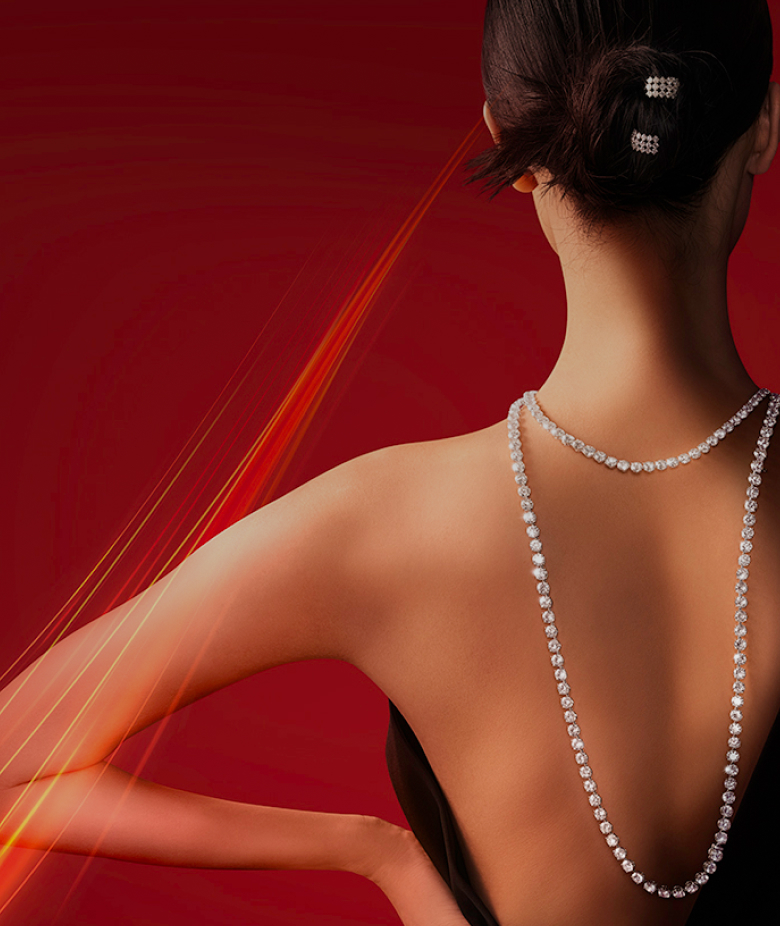15








- DIAMOND
- PERAL
- GEMS
- GOLD
- K GOLD
- PLATINUM
- SILVER
Diamond
Diamond 4Cs
Diamond weight is measured in terms of "Carat". One carat (ct) equals to 100 points. In that sense, 0.50 carat can be expressed as 50 points. The heavier a diamond is, the rarer and more valuable it is. Nevertheless, the value of two diamonds of the same weight may vary subject to the cut, clarity and colour. For instance, the value of an unpolished diamond will be 50% lower than a polished diamond.
The sparkle of diamond depends entirely on its cut. The perfectly meticulous and delicate cutting and polishing makes every piece of diamond a work of art. Cutting-edge technology and precise calculation, combined with professionalism, profound experience and rigorous attitude, are indispensable throughout the process of exploration, mining, cutting and polishing a natural diamond to transform a rough stone into a fiery scintillating diamond.
The sparkle of diamond depends entirely on its cut. The perfectly meticulous and delicate cutting and polishing makes every piece of diamond a work of art. Cutting-edge technology and precise calculation, combined with professionalism, profound experience and rigorous attitude, are indispensable throughout the process of exploration, mining, cutting and polishing a natural diamond to transform a rough stone into a fiery scintillating diamond.
Subtle hue exists in every piece of natural diamond. There is only a subtle difference between each grade, while the sparkle of diamond remains unchanged. In the diamond 4Cs, the colour-grading scale begins with the letter D. The whiter a diamond is, the more valuable it will be.
Clarity refers to the level of "purity" of a diamond. Diamond is a natural mineral and it may contain inclusions, cracks or other compounds. Such natural imprints might hinder the light from travelling through the diamond, and hence negatively affecting its appearance and brilliance. The fewer inclusions and defects a diamond has, the higher its clarity is. Since more lights travel through the diamond, it will be more brilliant. It is, therefore, more valuable.
In general, with the same grade in terms of colour and weight, a diamond with a higher clarity is of higher value.
- D to F colour: "colourless"
- G to L colour: "near colourless" in general
- M to Z colour: showing "light yellow" gradually
However, if the yellow hue of a diamond is stronger than the colour scale Z, it will be regarded as a fancy-colour diamond. Diamond with special colour is generally referred to as coloured diamond. Apart from golden yellow, red, green, orange, blue, brown and black are commonly seen colours. A coloured diamond is rarer than the colourless one and thus more precious. The value of coloured diamond is subject to its tone and saturation. Generally speaking, the price of pink, red and blue diamonds are higher than that of green and yellow diamonds.
- FL is extremely rare - no inclusions or blemishes visible under 10x magnification, which is considered as flawless
- IF is rare with no inclusions but with a few flaws
- VVS1, VVS2 - very minute inclusions that are very difficult to see
- VS1, VS2 - minor inclusions that could not be noticed easily
- SI1, SI2 - a few flaws noticeable easily with naked eyes
- I1, I2, I3 - obvious flaws noticeable easily with naked eyes
Caring for Diamond Jewellery
Taking care of diamond is not at all challenging. You could send your diamond jewellery back to the jeweler for checking and cleaning every six months. Chow Tai Fook offers free checking and cleaning service for the diamond jewellery
Points to note when putting on diamond jewellery:
- Do not wear diamond jewellery when swimming for fear that chloride in pool water will damage and oxidize it
- Keep diamond jewellery away from bleach
- Try to keep diamond jewellery separately from other jewellery as much as possible to avoid wear and tear from friction
- Grease may tarnish diamond jewellery when wearing, so it must be cleaned regularly to preserve its inherent glitter
- Put a few drops of detergent in a container before pouring in hot water. Then put diamond jewellery in it. Afterwards, use a soft brush to clean the table and bottom of diamond, and rinse the detergent off. The diamond jewellery should be air dried on a piece of cloth that do not contain cotton to air dry.
- If grease on the surface cannot be rinsed off, you can try to soak the diamond jewellery into a half cup of diluted ammonia water for 30 minutes and then clean the diamond with a brush. Do not use bleach to clean diamond jewellery.
Pearl
Pearls are commonly classified into three main categories, namely, natural, cultured and freshwater.
Pearls are from shelled mollusks. Seashells with mantle tissue can produce pearls. When seashells come open, sand, microorganisms and the like will come into contact with mollusks. In response, the mantle tissue of mollusk secretes nacre to wrap up the intruding agents into a pearl sac. Following years of development, the intruding agents are wrapped up in layers of secretion, pearls are thus resulted.
The formation of cultured pearls is strikingly similar to that of the natural pearls. The difference lies in nacre secreted in response not to the natural intruding agents but to the round nucleus inserted deliberately into it by culturists to stimulate the secretion of nacre and coat the nucleus layer after layer, which develop into a brilliant cultured pearl. To do this, culturists usually dredge up a seashell and prize it open with tools. A small incision is made in the flesh to insert a nucleus into it and a tissue grafted from the same species onto the nucleus, together with a little antibiotic medicine, before putting it back into the sea. An inspection on the seashell is conducted after six weeks. Culturists keep cultivating the healthy seashells in the sea. Cultured pearls are produced some three years later. In general, cultured pearls include South Sea peals, Black pearls and the cultured pearls from Japan and China. Currently, South Sea pearls and Tahitian pearl are the more extinguished and valuable cultured pearls in the market.
Subtle hue exists in every piece of natural diamond. There is only a subtle difference between each grade, while the sparkle of diamond remains unchanged. In the diamond 4Cs, the colour-grading scale begins with the letter D. The whiter a diamond is, the more valuable it will be.
South Sea pearls originating from the waters of South Pacific (that is the north-west sea of Australia and the sea around the Philippines and Indonesia), are nurtured in a wild shelled mollusks called white-lip pearl oyster. Since white-lip pearl oyster is an extremely precious and vulnerable creature that must be cultivated in a stable and unpolluted bay. It is also the largest mollusk in the world, in that sense, the South Sea pearl it cultivated is generally larger than ordinary freshwater pearl, cultured pearl or Tahitian black pearl in terms of size. South Sea pearls are, by all means, more valuable. The value of South Sea pearls is subject to the size, colour, shape, luster and clarity. The striking silvery pink pearls that are giant and round are considered as the most precious pearls. Pearls with diameters of 18 to 20 mm are rather rare. South Sea pearls come into different shapes, including round, oval, , button-shaped and baroque. The rounder a pearl is, the scarcer it is.
Tahitian pearls, which are different from Japan pearls and South Sea pearls, are extraordinary. Because the pearls are cultivated from a valuable black-lip pearl oyster (a rare seashell that grows exclusively in pure and natural Polynesian waters), different degrees of the grey bring out intriguing hues, which makes the pearls standing out from others, not to mention its special cultivation environment and the extremely rigorous requirements on pearl fishing. Only 50 out of the 100 black-lip pearl oysters with nucleus inserted can successfully produce pearls, only five of which are flawless, therefore, every pearl is treasured.
Freshwater pearls, the cultured pearls without the insertion of nucleus, mostly cultivated in mollusks in rivers or lakes. The procedure it received is similar to that of the cultured pearl, but the size of freshwater pearl is smaller. Since a mollusk can nurture up to dozens of freshwater pearls, the price of freshwater pearls is, therefore, lower than that of the seawater cultured pearl.
Caring for Pearl Jewellery
- To avoid the luster and colour of pearl being affected, pearl should be kept away from acidic substances and chemicals, such as perfume, soap and hair spray
- Do not put on pearl while cooking. As steam and oil fume can penetrate the pores of the pearl surface into the core of pearl and make it tarnished
- After the pearls are worn (particularly on sizzling hot days), they must be cleaned with a piece of wet cloth before being replaced in a safe
- Do not rinse the pearl necklace with water, as water can penetrate into the pores of pearl, which is not only difficult to dry it, but also leave the string to become moldy. If you are sweaty when wearing pearls, you can use a piece of wet and soft cloth to wipe them gently. Replace them back in the designated place after they are air-dried.
- Since pearls contain a certain amount of water, they should be kept in a cool place to avoid direct sunlight. They should not be kept in a place with low humidity either in case the pearls would be dehydrated.
- Pearl jewellery should be kept separately in case the surface of pearls would be scratched by other jewellery
- Do not hang pearl necklace on a long term basis. The string can be lengthened and loose over time
- Have your pearls restrung on a regular basis (preferably once every three years) by a jeweler as the string may become damaged
Gem
Ruby is originated from Latin term Ruber, which means red, while Sapphire is derived from Latin term Sapphins, which means blue. With its translucency and glamourous shade, ruby has long been regarded as an amulet in ancient times. In medieval Egypt and Rome, rubies were used to adorn cathedrals and monasteries. Rubies, as well as diamonds and pearls, were indispensable for adorning royal crowns and regalia of emperors and aristocrats throughout history. Rubies are principally originated from Myanmar, Thailand, Vietnam and Africa, while Sapphires hail from Myanmar, Sri Lanka, Madagascar in Africa, Kashmir and Australia.
Emerald, a variety of the mineral beryl, has always been a precious gemstone. Legend has it that emerald protects the eyes of the wearer and enlivens the spirits. The ancient Greeks referred it as "the luminous gem". Symbolizing eternal life and faith, emerald also represents nature's beauty and a good harvest. It is also worn by lovers as it empowers them to stay loyal and chaste unswervingly throughout their lives. Emeralds mainly hail from Colombia, Zambia in Africa and Brazil. Considering that the market is rife with artificial gemstones, Chow Tai Fook has sent the hand-picked staff members who are knowledgeable about gemstones to various origins of gemstones and markets to select excellent gemstones, so as to protect customers' benefits and ensure the supply of products with superb quality. The exceptional gemstones, combined with impeccable technique for mounting and glamorous designs, exquisite jewellery is thus made available to every customer who can be assured of the superb quality.
Caring for Gemstones
The cleaning and caring for gemstone are basically the same as diamonds. It should be kept separately in jewellery box or transparent plastic bag to avoid being knocked against by other accessories. To clean gemstones on your own, you can put gemstone jewellery into diluted soapy water and brush the gemstone and setting gently with a soft brush. Then rinse it and dry it with a piece of soft cloth. Don't forget to prepare a basin or plug the washbasin well before cleaning, to prevent the jewellery from going down the drain. Also, please be reminded that emerald should not be cleaned in ultrasound jewellery cleaner and must not be cleansed in highly soapy water or hot water, which would lead to tarnish or breakage of the emerald resulted from the vibration. Emerald is rather vulnerable, so care should be taken when wearing to avoid scratching.
Gold
Gold is a unique metal. Its value does not only lie in its scarcity, but also in its diversity of hues, high resistance to stain, as well as its ductility and malleability. The ductility of gold allows delicate patterns to be crafted. Since gold is highly malleable, a single ounce of gold can be turned into a thread measuring 25 km long and can be beaten into a sheet covering 50 square metres. The commonly seen 24K stands for content of gold up to 999‰ , while 999.9 gold pioneered by Chow Tai Fook has become a highest standard in terms of the content of gold nowadays.
Caring for Gold Jewellery
You should keep away from chemicals like perfume, bleach or cosmetics when wearing gold jewellery to avoid chemical reaction. Gold reacts with metals like silver, mercury, lead, etc., readily to give white spots on the gold jewellery. Such white compound can be easily removed with a propane torch. Therefore, try not to contact the said metals as much as possible when putting on gold jewellery. In case of such a circumstance, all you have to do is to send the gold jewellery back to a jeweler to have it cleaned. Gold jewellery can generally be cleaned with diluted soapy water and then dried with a piece of soft cloth.
K Gold
The colour of gold is determined by the content of impurities. Natural gold displays a typical hue of golden. Gold can also be blended with other metals into alloys to enhance its hardness, durability and diversity of colours. Purity of gold is determined by the content of metal. Karat is used to refer to its value. 18-karat gold contains 75% gold with the imprint reads "Au750". The jewellery with higher content of pure gold is more valuable. Blending gold with other metals can create alloys with different hues ranging from light yellow to rosary red or white. When gold is blended with copper and silver, yellow karat gold is formed. White gold has higher silver content, whereas the blend of copper gives red or pink gold.
Caring for Karat Gold
- Keep away from chemicals like bleach, detergent and the like. Avoid wearing karate gold jewellery when doing house chores
- Clean karate gold jewellery with diluted soapy water and then dry it with a piece of soft cloth
- Remove fingerprints and stains from the surface with a piece of non-abrasive cloth like silver polishing cloth or glasses cleaning cloth
- Do not store karat gold jewellery with other jewellery items, especially diamonds. Its hardness will result in scratches. Karat gold jewellery should therefore be kept in a lined jewellery box individually
Platinum
Among the three precious metals (namely, gold, silver and platinum), platinum is the most uncommon, precious and durable. Platinum is 30 times rarer than gold. Around 1,500 tons of gold is mined around the world every year, compared with only 160 tons of platinum. There are not many places with platinum mines either. The main producers include South Africa and Russia. The intensely high density of platinum makes it relatively heavier per unit volume. A platinum ring weighs 60% more than a 14-karat gold ring of the same volume. The purity of platinum is usually indicated with 900 or 950. Platinum jewellery in such purity does not discolour or tarnish easily. Nor does it cause allergy. Its brilliant white luster goes well with the dazzle of diamond. The high density of platinum means it has greater resistance than pure gold. Platinum is highly unreative and has excellent resistance to corrosion. All precious metals scratch, and platinum is no exception.
Caring for Platinum Jewellery
- Keep away from chemicals like bleach and detergent
- Clean platinum jewellery with diluted soapy water and then dry it with a piece of soft cloth
- Remove fingerprints and stains from the surface with a piece of non-abrasive cloth like silver polishing cloth or glasses cleaning cloth
Sterling silver
Pure silver is an easily scratched metal. Owing to its rather ductile property, ordinary alloys need to be blended in the jewellery making. Indications of purity range from 1000(100), 950(95), 925(92.5), 900(90), 800(80) to 750(75). The figures mentioned above refer to the content of silver. In general, 1000 refers to pure silver, but it is too ductile for any jewellery production. 925 content of silver prevails, therefore it is called 925 silver
Caring for Pure Silver Jewellery
Pure silver jewellery should be kept in a sealed plastic bag after wearing. Clean the surface of jewellery with warm water, together with chloride-free detergent. Then dry it with a piece of cloth and finally wipe its surface gently with a silver polishing cloth.
Are the items available online and in stores the same?

Items sold online may be online exclusive. Take this opportunity and order online at once.
Why do the unit prices differ for the same design?

Prices may vary for the same design because of different production dates and thus the cost of materials. Moreover, prices are subject to the shape of the diamond and its 4Cs (Colour, Clarity, Cut, and Carat).
If I could not find any desired item online, could you help me search or make recommendations?

We are pleased to help
our customer to look for relative items. Please contact our online
customer service officer or send the details via WhatsApp to (852) 3018
8001. To provide a prompt response, please state the specifics of your
preferred items, including but not limited to:
✓ Style (e.g., pendants, earrings, bracelets)
✓ Material (e.g., gold, diamond, gemstone, 18K gold, 950 platinum, etc.)
✓ Price
We will launch the item as soon as possible for your purchase upon your confirmation.
Is customer-supplied order available?

Currently, the website does not support customer-supplied orders.

(852) 2526 8649
- 9:00 - 18:00
- Mon - Fri
- Public Holidays are excluded
- Contact Us
- Terms of Use
- Privacy Policy
- Official Statement
-
Related Sites
- © 2024 Chow Tai Fook Jewellery Company Limited

House of CTF

Customer Service

(852) 2526 8649
- 9:00 - 18:00
- Mon - Fri
- Public Holidays are excluded
- Contact Us
- Terms of Use
- Privacy Policy
- Official Statement
-
Related Sites
© 2024 Chow Tai Fook Jewellery Company Limited




























